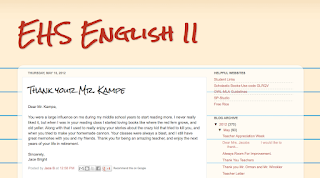I'd like to share with you 10 helpful websites for the secondary teacher when using laptops or utilizing a computer lab. My school district adopted the 1:1 laptop initiative four years ago, purchasing Apple MacBook Pros for all students in 6th - 12th grades. So while I am no expert on technology in the classroom, I have used all of these websites in class with my students. I know there are numerous sites out there just as good or maybe even better, but I wanted to share those which I have had success with my high school students.
 1. Free Rice: Why do I like this website? You can read about using it here and ways to incorporate it into your classroom here. The short version: it helps students build their vocabulary, exposing them to new words and repeating them several times. And the time they are spending "playing" the game is all toward a good cause: feeding the hungry. When students finish early but we don't have enough time to start a new activity, they can either read silently or play Free Rice.
1. Free Rice: Why do I like this website? You can read about using it here and ways to incorporate it into your classroom here. The short version: it helps students build their vocabulary, exposing them to new words and repeating them several times. And the time they are spending "playing" the game is all toward a good cause: feeding the hungry. When students finish early but we don't have enough time to start a new activity, they can either read silently or play Free Rice.2. Turn It In: We realized pretty quickly when we started going paperless for most writing assignments that our students were too tempted to take short cuts by copying and pasting even simple assignments such as journal entries, poems, literature responses, and essays. It took hours to grade assignments because I had to copy & paste their responses in to Google and free plagiarism checkers. We decided to subscribe this year to Turn It In and it has definitely cut back on the amount of copying. Just knowing the assignment will have to be submitted there first is a deterrent. (It also saves their writing samples, so any student who turns theirs in with similar content will be flagged--including a sibling years later.)
ALTERNATIVES: If your district cannot afford a subscription, there are some alternatives, though not as good. Try PaperRater or Grammarly. PaperRater won't check for authenticity, but it's not bad for catching errors. Grammarly will ask for a subscription for detailed results, but it will tell you if there is questionable text first. A good originality checker is Small SEO Tools; it's target audience may not be education, but it still serves the purpose.
3. Socrative: Socrative is a fast, fun way to engage students and check overall understanding. Plus, the kids love it. There's very little set-up (teachers have to create an account ahead of time then provide students with the url). I used this for review games (no need to type anything in, just read your questions and students type their answers in). I projected their answers so they could see how everyone else answered. It's a great listening activity because if they miss the question, their answer won't appear first; that was a key motivator for many of the boys in my classes. You can use this at the end of the class period to check understanding, though it's a site to use sparingly or the novelty will probably wear off.
 4. Today's Meet: This is essentially a chat room, so you are probably wondering why I would encourage this during class. First, let me tell you about my students. I have two classes of sophomores who are really great kids, but as soon as I stop speaking, they begin talking. If I am showing a video clip or one of their classmates is speaking, they see that as an invitation to start a discussion with their neighbor. Instead of constantly shushing them, stopping the video, or interrupting their classmate to scold them, I decided to look at why they were talking. They obviously weren't engaged in the activity. I first thought we could use Twitter during these activities using a class hashtag. But some students didn't want to open new accounts and/or did not want to share their personal accounts with the class. So I looked for alternatives (iChat, Google Chrome, and other built-in chat features were disabled from their laptops for excessive student abuse). I found Today's Meet and thought it would be perfect: no account registration, the chat is deleted after a set period of time but can be recorded if needed, and I just have to give students the chat room name. Yes, we had some students abuse it by creating several user names and posting childish responses, but for the most part, it was very engaging. I used it while we watched a video, posting discussion questions for response and allowing them to ask questions during the clip. I've also used it while students listened to podcasts so they could express their thoughts without interrupting the audio.
4. Today's Meet: This is essentially a chat room, so you are probably wondering why I would encourage this during class. First, let me tell you about my students. I have two classes of sophomores who are really great kids, but as soon as I stop speaking, they begin talking. If I am showing a video clip or one of their classmates is speaking, they see that as an invitation to start a discussion with their neighbor. Instead of constantly shushing them, stopping the video, or interrupting their classmate to scold them, I decided to look at why they were talking. They obviously weren't engaged in the activity. I first thought we could use Twitter during these activities using a class hashtag. But some students didn't want to open new accounts and/or did not want to share their personal accounts with the class. So I looked for alternatives (iChat, Google Chrome, and other built-in chat features were disabled from their laptops for excessive student abuse). I found Today's Meet and thought it would be perfect: no account registration, the chat is deleted after a set period of time but can be recorded if needed, and I just have to give students the chat room name. Yes, we had some students abuse it by creating several user names and posting childish responses, but for the most part, it was very engaging. I used it while we watched a video, posting discussion questions for response and allowing them to ask questions during the clip. I've also used it while students listened to podcasts so they could express their thoughts without interrupting the audio.5. Blogger: Writing is an activity that, when practiced often, builds not only better writers, but better thinkers. Writing for a blog can be difficult. Challenging. Even scary sometimes. So of course I want my students to try it! Setting up a class blog or individual blogs is very easy with Blogger. (Read more about our class blogs here.) I use it for journal entries and this year had my students post their short stories on their blog. Their classmates gave them anonymous feedback via Google Drive forms (only people logged in to our district can submit the form, so if you visit the site you'll see their stories, then a locked form). Slowly, their writing starts to improve as they realize they have a global audience.
6. Project Gutenberg: Over 42,000 free online books, including many classic literature pieces. If your class is reading Tom Sawyer or Jane Eyre, your students can download the free ebook on the site rather than use a paper copy. Here's the top 100 most popular downloads.
7. LibriVox: While Project Gutenberg provides the print copy, LibriVox provides the audio versions of books, stories, and poems. Your students can even record themselves reading literature to donate to the website. I have many students who love listening to the works we read (and many works--especially poems--are meant to be read aloud), so it's wonderful to direct them here so they can listen anytime. The recordings can be downloaded, too, so if they do not have internet access at home, they'll still have the recording. A search for Shakespeare turns up over 100 files, with some links leading to even more.
 8. Quizlet: Free Rice is great for building vocabulary of random words, but Quizlet lets you create the word lists for online games, flash cards, and study lists. You can import your word lists or just type them in. Create lists for each chapter of a unit or for an entire novel. Your students will be able to go to your list to retrieve the words and definitions and utilize the built-in games for reviewing.
8. Quizlet: Free Rice is great for building vocabulary of random words, but Quizlet lets you create the word lists for online games, flash cards, and study lists. You can import your word lists or just type them in. Create lists for each chapter of a unit or for an entire novel. Your students will be able to go to your list to retrieve the words and definitions and utilize the built-in games for reviewing.9. Google Drive (Formerly Google Docs): While I hate Google Docs as a word processor, it is a nice way for students to compile an online portfolio of their writing samples. I have my students type their essays using Mac's Pages, then they upload it to Turn It In to get feedback on grammar, usage, and whether they cited sources correctly. After they receive feedback, they revise their drafts and can resubmit to Turn It In. I also have them upload it to Google Drive. Because they all have Google Drive downloaded on their computers, it's a matter of dragging the file to their Google Drive folder. This way they have their final draft saved online in case they lose all their files on their computer. (This happens a lot because students use their desktop to save files, which doesn't sync with the server. If they didn't back it up on Google Drive or Turn It In, I usually have no sympathy for them. They've had their laptops for four years, so they should know better! ) Besides using it as an online portfolio, it is nice for students to use for collaborative assignments, creating forms and surveys like voting for Homecoming court and to poll their classmates on various issues. Here's a document that offers 37 ways to use Google Docs in the classroom; and 81 Interesting Ways to Use Google Forms in the Classroom.
10. YouTube: YouTube is a site that I both love and hate. It is definitely one of the biggest time-sucks for many of our students. They will spend hours just watching stupid videos, then complain that they had no time to get their homework done. So while I would love for YouTube to just not exist, I also find that it can be rather resourceful for educational videos. I created several playlists that I will refer to for enrichment of a topic or piece of literature. Students can subscribe to my channel here, here, or here to find videos I WANT them to watch. Why do I have three channels? One is my school account, another is my personal account (but I use it mainly for educational purposes), and the third was my first YouTube account before Google took over and made me create a new account.
For additional tips and links, you can follow my 1:1 Education Technology board on Pinterest.
Not mentioned, but worth noting: having an online grading app is essential. Our district uses Skyward, which handles grades, attendance, lunch accounts, registration, and discipline records. When I create an assignment in my gradebook, I can securely upload a file they can download. (I never share on Google Docs or any other website because once you share, they are picked up by Google searches and become part of the internet where future students can easily find them.) I can also create online assignments, quizzes, and tests that are secure. The best part? It automatically grades and records them for me after students complete. Having a SECURE way to transfer assignments is definitely something a district needs to have in place before implementing a 1:1 initiative. Do not assume outside websites are secure--they aren't.
Let's Share! If you teach in a 1:1 school or are able to use a lab regularly, post your favorite websites to use in class below.





















